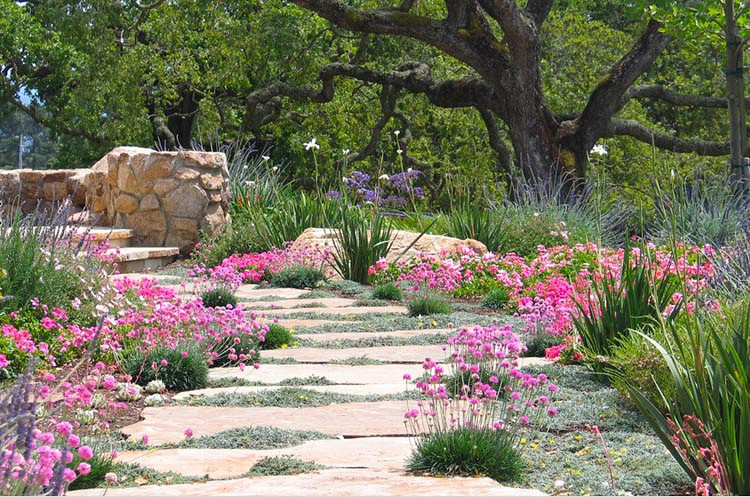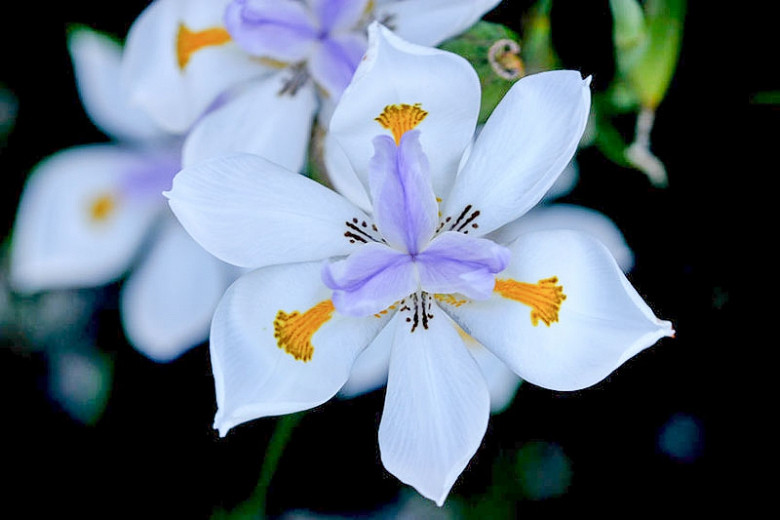Dietes iridioides (Fortnight Lily)
Native to Eastern and Southern Africa, Dietes iridioides (Fortnight Lily) is a rhizomatous evergreen perennial with attractive flowers resembling small Japanese Irises. They appear on branched stalks over an incredibly long season, extending from spring to fall and sometimes well into winter in mild climates. Flowering occurs in bloom bursts that seem to occur at 2-week intervals, hence the common name of Fortnight Lily. Each waxy white flower, 3 in. wide (7 cm), consists of 3 outer and 3 inner segments, the latter being adorned with yellow-orange blotches and a few orange marks at their base. Radiating from the bloom's center are 3 pale violet style arms. The flowers last one day but are quickly replaced by new ones as each stalk carries an endless supply of buds. They rise above fan-shaped clumps of narrow, sword-shaped, stiff, evergreen leaves. A spectacular plant in mass plantings, as a groundcover, or in containers.
- Easy to grow, Fortnight Lily performs best in full sun or part shade, in moderately fertile, moist, well-drained soils. Best flower production occurs in full sun, but light afternoon shade is welcomed. Thrives with regular moisture but will perform satisfactorily in poor soil with infrequent watering once established. It is fairly drought tolerant and is reported to be moderately salt tolerant
- No serious insect or disease problems. Watch for crown root, root rot, rust, scale, and nematodes.
- A welcomed addition to Mediterranean gardens, and coastal gardens. Most spectacular when planted in large groupings where it develops a bouquet effect
- Remove seed pods to promote additional bloom. Flower stems should not be removed after flowering. Clip off any leaves that die. Self-sows freely; deadhead if you do not want volunteer seedlings next season.
- Propagate by seed or division of the rhizome.
- Parts of plants are poisonous if ingested. Handling plants may cause skin irritation or allergic reaction.
Requirements
| Hardiness | 8 – 11 |
|---|---|
| Heat Zones | 8 – 12 |
| Climate Zones | 8, 9, 12, 13, 14, 15, 16, 17, 18, 19, 20, 21, 22, 23, 24, H1, H2 |
| Plant Type | Perennials |
| Plant Family | Dietes |
| Exposure | Full Sun, Partial Sun |
| Season of Interest | Spring (Late)Summer (Early,Mid,Late)FallWinter |
| Height | 2' – 4' (60cm – 120cm) |
| Spread | 2' – 3' (60cm – 90cm) |
| Spacing | 36″ (90cm) |
| Water Needs | Low, Average |
| Maintenance | Low |
| Soil Type | Loam, Sand |
| Soil pH | Acid, Alkaline, Neutral |
| Soil Drainage | Moist but Well-Drained, Well-Drained |
| Characteristics | Cut Flowers, Showy, Evergreen |
| Tolerance | Drought, Dry Soil, Salt |
| Garden Uses | Beds and Borders, Ground Covers, Patio and Containers |
| Garden Styles | Coastal Garden, Informal and Cottage, Mediterranean Garden |


